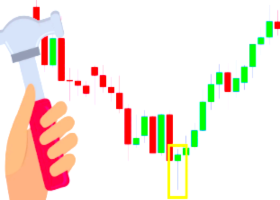
The GBP/AUD pair is showing early signs of a possible reversal.
It has formed a text-book hammer candlestick (circled) at the lows, hammer’s form at the end of extended down-trends, when the exchange rate moves lower but then recoups most of the day’s losses to close the day back up in the top third of the range.
They warn of a potential change in the trend, but they are generally short-term indicators.
The pair is further supported by the RSI in the bottom pane, which has moved from oversold back out of the oversold zone, which is a buy signal. RSI is a momentum indicator which gives a result between 1 and 100.
When it moves below 30 it is said the asset is oversold; when it moves back above 30 it’s a signal to liquidate shorts and buy the asset instead, as the short-trend may have changed.
Another indicator ADX is above 50 which is a sign the trend is reaching an exhaustion point, providing further indication that the asset may be bottoming.
ADX measures how strongly an asset is trending. When it measures over 50 it is often a sign of over exhaustion. The pair may either now start going sideways for a time or reverse trend and start going higher.
The down-trend is in doubt but not ruled out
There is a possibility of a continuation lower despite the signs that the pair may be oversold or exhausted. This may come after a period of consolidation or a correction. There is insufficient evidence yet the pair may correct higher.
Eventually it is still probable the pair will continue lower in line with the dominant long-term bear trend, and a break below the current 1.8652 lows would probably lead to a continuation down to the S2 monthly pivot at 1.8410.
Aussie fundamentally sound
The Aussie has been supported by a rally in commodities, which has seen WTI Crude rise above $40/barrel and Iron Ore, the country’s number one resource, rise to above $60/tonne.
A relatively strong housing market, reasonably low unemployment, and an economy which has adjusted well to being more services-orientated are just some of the reasons why AUD has recovered.
The Reserve Bank of Australia’s base lending rate of 2.0% is relatively high within the G10 (only lower than RBNZ) and is still a magnet for investors searching for interest on their savings or the carry trade.
In a recent note, Credit Suisse viewed current market expectations that the RBA would cut rates in 2016 as over-exaggerated, expecting the RBA to stay on hold instead.
Indeed, conviction that the RBA will remain on hold for the rest of the year appears to have gained as a result of recent data showing a fall in the unemployment rate from 6.0 to 5.8% in February.
Sterling meanwhile remains dogged by the threat of Brexit, with recent downward pressure coming from polls showing the vote likely to be extremely close run.
Economic Data
In the week ahead there is a dearth of Australian Data, with only the House Price Index, on Tuesday 22, which rose 10.7% in the previous quarter.
Crude Oil Inventories on Wednesday 23 could also impact on the Aussie.
For the UK there is Headline UK CPI (yoy), which is forecast to come out at 0.4% in February from 0.3% previously. The previous three prints were positive.
UK Public Sector Net Borrowing for February is expected to rise to 5.4bn from -11.8bn previously.
PS: Copy signals, Trade and Earn $ on Forex4you - https://www.share4you.com/en/?affid=0fd9105


